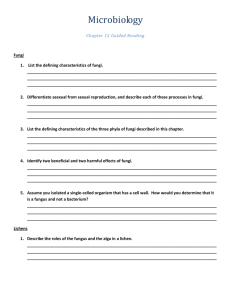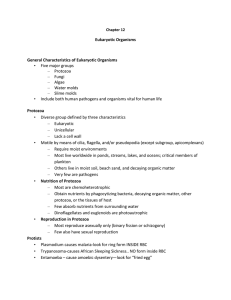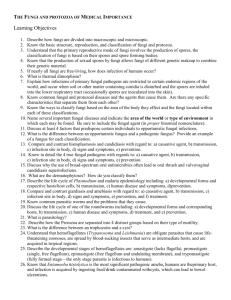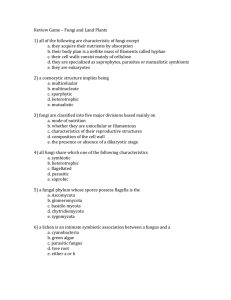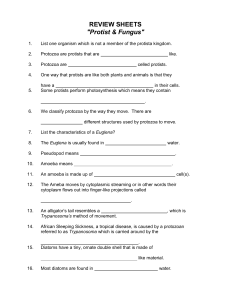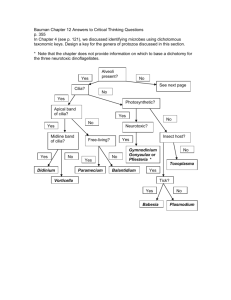Selected Fungal, Protozoan, and Parasite Diseases
advertisement
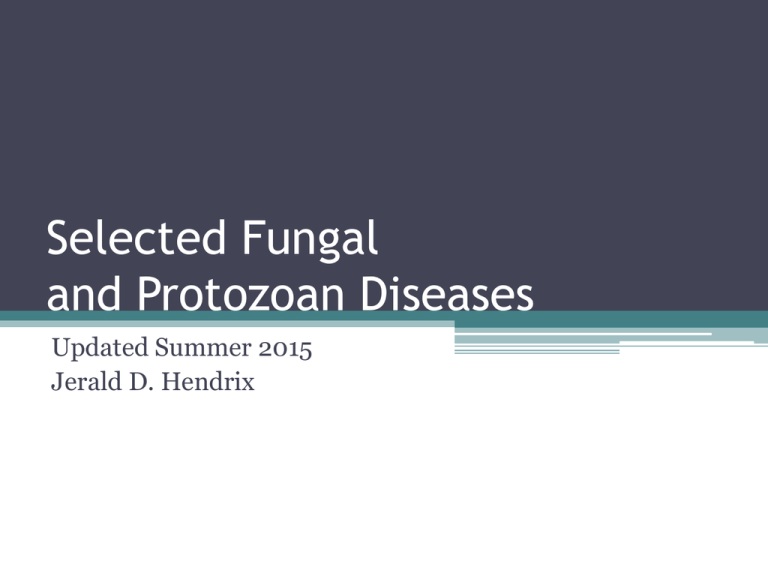
Selected Fungal and Protozoan Diseases Updated Summer 2015 Jerald D. Hendrix Properties of the Fungi • Basic properties ▫ Single celled (yeast) or filamentous (molds; fleshy fungi) ▫ Filaments are called hyphae (singular: hypha) ▫ Hyphae may be septate or nonseptate (coenocytial) ▫ All are heterotrophic chemorganotrophs; none are phototrophic ▫ Cell walls contain cellulose and may also contain chitin Properties of the Fungi • The Chytridiomycetes ▫ Probably the deepest branching fungal group, motile sexual spores • The Zygomycetes ▫ Reproduces asexually by producing haploid spores at the end of stalk-like sporangia ▫ Reproduces sexually when gametangia of opposite mating types fuse (plasmogamy) resulting in a dikaryotic sexual spore; when the spore finds favorable conditions, karyogamy and meiosis occurs, forming haploid cells that grow into hyphae ▫ Industrially important genera include Mucor, Rhizomucor, and Rhizopus ▫ Possibly related phylogenetically to microsporidia and glomeromycetes – two groups of asexually reproducing parasitic fungi Properties of the Fungi • The Ascomycetes (“Sac fungi”) ▫ Reproduce asexually by producing chains of haploid spores at the end of aerial hyphae ▫ Reproduce sexually when gametangia of opposite mating types fuse and form a diploid nucleus; meiosis occurs immediately to produce forming haploid ascospores; the ascospores are formed within sacs called asci ▫ Important genera include Saccharomyces, Neurospora, Sordaria, Morabella, Tuber, Schizosaccharomyces, Candida, Aspergillus Properties of the Fungi • The Basidiomycetes (“club fungi”) ▫ Sexual spores are formed on club-shaped structures called basidia ▫ Includes mushrooms and puffballs, Phanerochaete chrysosporium (white rot, used in bioremediation), Cryptococcus (important human pathogen), and smut & rust diseases of plants Fungal Diseases A. B. C. D. E. F. Candidiasis Dermatophytosis Cryptococcosis Histoplasmosis Blastomycosis Pneumocystosis Candidiasis • Cause: Candida albicans and several other species of the genus Candida ▫ An ascomycete ▫ Grows as yeast or pseudohyphae, dependent on cultural conditions (dimorphic) ▫ Very common normal flora in mouth, intestinal tract, and vaginal tract ▫ Many cases due to antibiotic usage (decreased bacterial flora to compete with Candida) and compromised immunity (such as AIDS) Candidiasis • Symptoms ▫ Mucosal candidiasis: Oral candidiasis (thrush), esophageal candidiasis, intestinal candidiasis, candidal vulvovaginitis, candidal balanitis ▫ Cutaneous candidiasis and candidal onychomycosis ▫ Systemic candidiasis: Candidal septecemia and liver damage Dermatophytosis • Cause: Several genera of dermatophytic fungi ▫ Trichophyton, an ascomycete ▫ Microsporum, an ascomycete ▫ Epidermophyton, an ascomycete ▫ Grow on skin, hair, nails ▫ Transmitted by contact with infected persons or animals Dermatophytosis • Symptoms ▫ Tinea infections: Red, scaly or blister-like lesions; often a raised red ring; “ringworm” ▫ Used together with Latin name of the body part: Tinea pedis Tinea corporis Tinea capitis Tinea barbae Tinea cruris Tinea unguium Cryptococcosis • Cryptococcus neoformans and Cryptococcus gattii • A basidiomycete • Spores in contaminated soil; esp. contaminated with bird droppings • Airborne to humans • Gelatinous capsules resist phagocytosis • Respiratory tract infections • Occasional systemic infections involving brain & meninges Histoplasmosis • Histoplasma capsulatum • An ascomycete • Airborne infection • Transmitted by inhalation of spores in contaminated soil • Associated with chicken & bat droppings • Respiratory tract symptoms; fever, headache, cough, chest pains Blastomycosis • Blastomyces dermatitidis • An ascomycete • Associated with dusty soil & bird droppings • Skin transmission: via cuts & abrasions • Raised, wart-like lesions • Airborne transmission: via inhalation of spores • Respiratory tract symptoms • Occasional internal infections with high fatality rate Pneumocystosis • Pneumocystis jirovecii (formerly Pneumocystis carinii) • An ascomycete • Transmitted by airborne contact • Usually asymptomatic or with mild respiratory symptoms • Causes severe pneumonia in immunocompromised persons • A major secondary infection & cause of death in AIDS patients Properties of the Protozoa • Cellular properties ▫ Eukaryotic microorganisms having animal-like cells ▫ No cell walls ▫ Most have heterotrophic metabolisms ▫ A few protozoa (eg Euglena) are photosynthetic Properties of the Protozoa • Cellular properties (cont.) ▫ Many are free-living in soil or aquatic environments; a few are parasitic ▫ Single-celled or simple colonial organization ▫ Classification based predominately on the mechanism of motility Properties of the Protozoa • “Trophozoite” and “Cyst” ▫ Some protozoa go through different stages in their life cycle. ▫ This is especially true of certain parasitic protozoa. ▫ Trophozoite: Actively growing and reproducing stage ▫ Cyst: A dormant stage, enclosed in a resistant cyst coat Properties of the Protozoa • Selected Protista ▫ Diplomonads and parabasalids Unicellular & flagellated Lack mitochondria and chloroplasts Parasites Giardia – a diplomonad; has mitosomes Trichomonas – a parabasalid; parabasal body supports golgi; no mitochndria but has hydrogenosomes; unusually large genome, highly repetitive, lacks introns but may encode around 60,000 genes (almost twice the number of humans) Properties of the Protozoa • Selected Protista (continued) ▫ Euglenozoans Unicellular, flagellated Trypanosoma and Leishmania, two genera of kinetoplastids the kinetoplast is a mass of DNA within their single large mitochondria Trypanosoma includes species of insect-borne parasitic flagellates, including causes of sleeping sickness and Chargas disease Euglena, a euglenid Photosynthetic with chloroplasts; can also live as chemorganotrophs in the darkness and can feed on bacteria via phagocytosis Properties of the Protozoa • Selected Protista (continued) ▫ Alveolates Characterized by alveoli – membranous sacks located just underneath the plasma membrane; function unknown Ciliates covered with cilia; oral groove; macronuclei and micronuclei, conjugation, many host endosymbionts Paramecium – free-living ciliate Balantidium – parasitic Properties of the Protozoa • Selected Protista (continued) ▫ Alveolates (continued) Dinoflagellates Diverse group of freshwater and marine phototrophic alveolates; part of the plankton Includes Gonyaulax, the “red tide” organism Apicomplexians Once known as the Sporozoa Nonmotile “adult” forms Contain apicoplasts (degenerated nonfunctional chloroplasts) and likely evolved from red-tide dinoflagellates Sexually reproducing (meiosis and chromosome segregation) Different life cycle stages may require different host species Example: Plasmodium, cause of malaria Properties of the Protozoa • Selected Protista (continued) ▫ Stramenopiles Diatoms – another photorophic plantonic group Golden algae (chrysophytes) and brown algae Golden algae are mostly unicellular; some are colonial Brown algae (Fucus) are mostly multicellular; seaweed Oomycetes Slime molds Originally classified as fungi Motile, flagellated sexual spores Includes Phytophthora, cause of the potato blight Properties of the Protozoa • Selected Protista (continued) ▫ Cercozoans and Radiolarians Once classified as amoebas because of pseudopods Cercozoans Chlorarachniophytes: Both freshwater and marine; “amoeba-like;” phototrophic; no test (shell) Foraminifera: Exclusively marine and form symetrical tests of calcium carbonate; may also host algal symbionts Radiolarians Also make calcium tests; typically lobed or spiked; exclusively heterotrophic Properties of the Protozoa • Selected Protista (continued) ▫ Amoebozoa Gymnamoebas – free-living amoebas; unicellular with pseudopod movement; genera Amoeba and Pelomyxa Entamoebas – parasitic, example Entamoeba hystolytica that causes amoebic dysentery ▫ Slime molds Once classed as fungi Dictyostelium Life cycle that begins as amoeba that slime together, aggregate, and form multicellular stalks (fruiting bodies) Protozoan Diseases A. B. C. D. E. F. G. H. Amebiasis Primary Amebic Meningoencephalitis Giardiasis Trichomoniasis Balantidiasis Toxoplasmosis Malaria Cryptosporidiosis Amebiasis • Cause: Entamoeba histolytica ▫ ▫ ▫ ▫ ▫ A parasitic amoeba Transmitted via contaminated food & water Cysts are shed in the feces When ingested: Excystation occurs in the intestine Trophozoites grow & reproduce in the intestinal tract Amebiasis • Symptoms ▫ Abdominal pain ▫ Little diarrhea but often blood in the stool (“amebic dysentery”) ▫ Possibly of intestinal ulceration; perforation; infection of internal organs such as liver & lungs Primary Amebic Meningoencephalitis • Cause: Naegleria fowleri ▫ A fresh water, free living ameba ▫ No cyst stage ▫ Several cases of infections in swimmers • Transmission and Symptoms: ▫ Transmission through the nasal & sinus passages ▫ Infection of the brain & meninges ▫ Headaches; delirium; seizures Giardiasis • Cause: Giardia lamblia ▫ A flagellated diplomonad ▫ The trophozoite has four pairs of flagella & two nuclei; giving it a face-like appearance ▫ Grows in the intestinal tract ▫ Cysts are shed in the feces Giardiasis • Transmission and Symptoms ▫ ▫ ▫ ▫ ▫ ▫ Transmitted via contaminated water & food Foul-smelling profuse diarrhea Sometimes chronic Often misdiagnosed Diagnosis via microscopic examination Enterotest capsule Trichomoniasis • Cause: Trichomonas vaginalis ▫ Flagellated parabasalid ▫ No cyst stage • Transmission & Symptoms ▫ ▫ ▫ ▫ Transmitted via sexual contact Genital itching Painful urination with a white, mucoid discharge Occasional reduction of sperm count or erosion of the cervix Balantidiasis • Cause: Balantidium coli ▫ Ciliated alveolate ▫ Trophozoites grow in the intestinal tract ▫ Cysts are shed in the feces and may remain embedded in intestinal walls, causing chronic infections • Transmission & Symptoms ▫ Contaminated water & food ▫ Ulceration in intestines ▫ Profuse diarrhea Toxoplasmosis • Cause: Toxoplasma gondii ▫ Alveolate apicomplexian ▫ Both asexual & sexual stages ▫ Invasion of several areas of the body, including internal organs & muscle tissue ▫ Possibly the most prevalent protozoan parasite of humans Toxoplasmosis • Transmission & Symptoms ▫ Transmitted via eating contaminated meat ▫ Cysts are found in the meat, especially of grazing animals such as cattle ▫ Cats can transmit the disease through their feces ▫ Lymph node swelling; flu-like symptoms Toxoplasmosis • Transmission & Symptoms (cont.) ▫ Generally mild in non-immunosuppressed persons ▫ Severe infections in immunosuppressed persons ▫ Pregnant women are in danger of fetal damage or miscarriage Malaria • Cause: Plasmodium species ▫ Alveolate apicomplexian ▫ Complex life cycle requiring two hosts: a mammal (human) and the mosquito Anopheles Malaria • Transmission and Symptoms ▫ The asexual merozoite stage infects human blood from the bite of a mosquito ▫ The parasite invades erythrocytes & reproduces ▫ Erythrocytes break open & release the parasite; this causes the characteristic fever, chills, anemia, weakness, hemorrhaging ▫ Intense fever & chills about 48 - 72 hr after exposure, due to the simultaneous rupture of so many erythrocytes Malaria • Transmission and Symptoms (cont.) ▫ The sexual stage of Plasmodium develops in the human host and is picked up by a mosquito ▫ The sexual stage is completed in the salivary gland of the mosquito to complete the cycle ▫ Treatment by quinine & other antimalarial drugs Cryptosporidiosis • Cause: Cryptosporidium species ▫ Alveolate apicomplexian ▫ A common protozoan parasite in humans • Transmission and Symptoms ▫ Contaminated water ▫ Mild diarrhea in non-immunosuppressed persons ▫ Severe diarrhea in immunosuppressed persons
